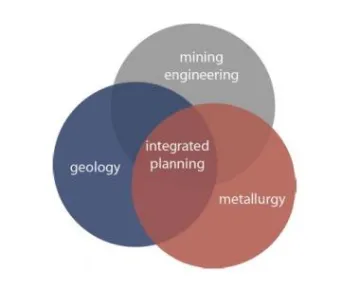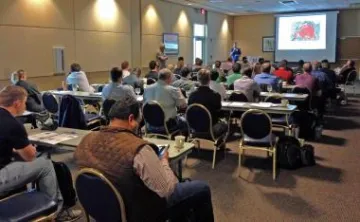Professional Development Course Series “Integrated Planning”
|
first published: August 2020 Lowell Institute collaborates with industry partnersTo extend professionals’ horizons toward the rest of the mining value chain, the Lowell Institute collaborated with Newmont Mining and Freeport-McMoRan to develop a series of three short courses on Integrated Mine Planning. Isabel Barton, Assistant Professor in the University of Arizona Department of Mining and Geological Engineering, confirms: “The first impulse for the series actually came from our industry partners, who made us aware that lack of communication is a common problem in the industry.” Ralph Stegen, Vice President Exploration at Freeport-McMoRan explains the industry’s rationale: “Reserves are a key facet for any mining company. Their determination involves numerous entities including exploration, engineering, and metallurgy. Each of these groups generate significant amounts of data and observations that are used in the calculation of reserves, and they need to work collectively through the generation and exchange of data in the reserve determining process. Important in the exchange of data between groups is understanding of the fundamental aspects of what each group does and the character of the data they generate.” |
The first course in the series, Geological Inputs to Integrated Planning, covers geology of ore deposit formation and geological factors affecting the discovery and development of mineral resources through all stages of the mine life cycle. Mine Engineering Inputs to Integrated Planning, introduces the role of mine design and planning, geotechnical engineering, resource estimation, and other mine engineering factors in the development of mineral resources. The third course, Metallurgical Inputs to Integrated Planning, focuses on how processing and extraction of different ores affects the design, development, economics, and operation of mines. |
Cross-disciplinary Format

Each course introduces the fundamentals and role of one profession, from the perspective of its members - top geologists, engineers, and metallurgists – in the mining industry and academia. The main target group for each course is the respective two other professions: mining engineers and metallurgist for the geology part, geologist and metallurgists for the mine engineering part and geologist and mine engineers for the metallurgy part. However, the courses are designed so that they don’t require in-depth prior knowledge, and therefore can draw participants from wide-ranging backgrounds, including lawyers, accountants, and structural engineers.
While it is beyond the scope of a two-day course to provide an in-depth education in the respective field, it can break down barriers to communication and facilitate interdisciplinary understanding, a process that can otherwise take years of experience.
The course series was held on campus for the first time in 2017/2018, with a class size of around 30, drawing participants mainly from Arizona and neighboring states as well as Mexico. The decision to hold the class at the university rather than at individual companies means that participants can come from a range of different companies, and university students can also attend.
“Geological Inputs”
Since geology-based exploration is the first step in the mining life cycle, the series starts with Geological Inputs to Integrated Planning. This course, aimed junior-to mid-level mining engineers and metallurgists, was developed in collaboration with Newmont Mining and has been offered, since 2017, with support from Freeport-McMoRan Inc.
“The goal is not to turn a mining engineer into a geologist. It is more of a geology appreciation class.”
Ralph Stegen
The first course day begins with an introduction to geological terms and concepts. Isabel Barton: “We found that the various professions, when they speak with each other, don’t always speak the same language. We are quite literally providing a common vocabulary.“ Processes that took and take place long before the actual mining are in focus on the first course day: Rocks forming and degrading. Why geology matters in mining in all stages is stressed by concentrating on ore deposits and their characteristics. The presenters also made sure to point out these geological basics have important consequences by always including a slide on “why does this matter”.
Participants were able to explore the characteristics of various minerals in a very hands-on activity: They tried to match six samples from the University’s mineral collection prepared as a testing kit to a list of minerals. In a second activity, they compared ore samples from different deposits. Isabel Barton: “The partner or group activities enable a different kind of learning from presentation style. But the presentations themselves are also very interactive, and it is common that participants take the floor to add examples or anecdotes from their daily practice. One participating mining engineer called it ‘tons of real-life experience’.”
“Geology is messy” is a truism among geologists, and some of this messiness in the form of faults, joints, and other discontinuities is presented at the end of the day. Participants found it helpful to understand the amount of information and preparation that is needed to even get to the point of planning.

Participants of "Geological Inputs to Integrated Planning" in 2019
The second day follows the discovery and development of mineral resources through all stages of the mine life cycle, from planning the mine to operations and processes. In another activity, participants can try their hand at interpreting the data gained by drilling. Using cross-sections for modeling and interpolating the data was an eye-opener for many participants. “I didn’t realize how difficult this is” was a remark heard more than once.
The role of geology doesn’t end with mine operations: Geologist look far ahead to the period when the mine is not in active use anymore. A reclamation plan must be set in place for its closure before a mine is allowed to open, and the geology of the site determines what you can and cannot do with the premises after a mine is closed for operation – maybe convert it to a botanical garden or even an underground trampoline park!
The wrap-up panel with a mix of industry and university representatives discuss the collaboration between the different professions by turning around the question: Rather than asking what input geology can give to the other areas they now ask “What do geologists need from mining engineers and metallurgists?”

